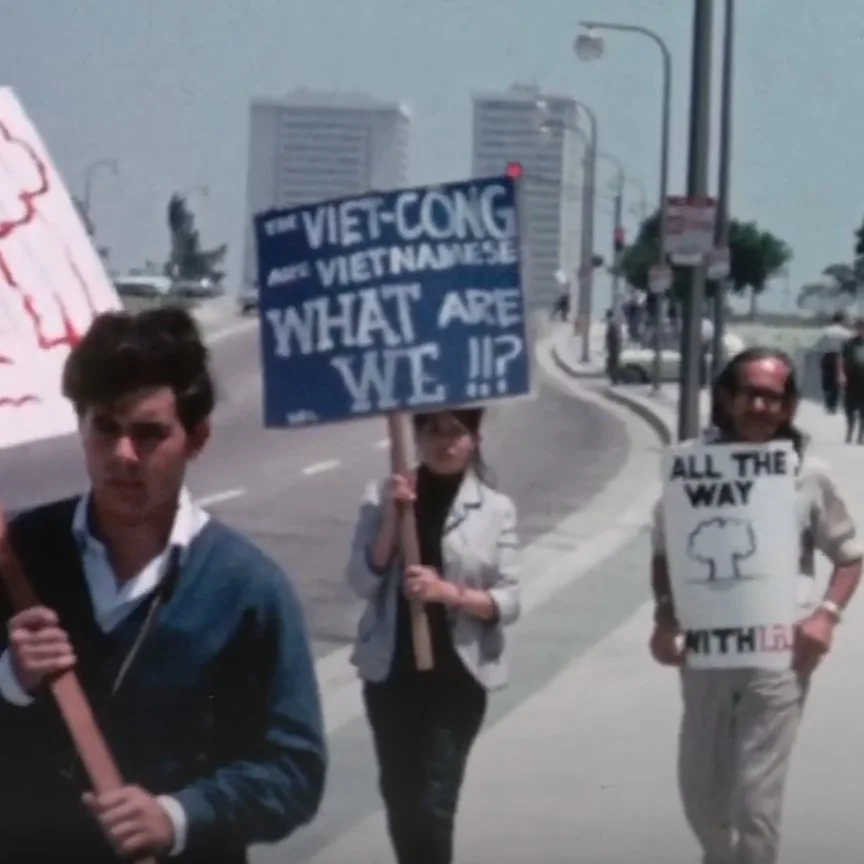Peace Action Council
The Vietnam War protests in the late 1960s were a significant social and political movement in the United States, reflecting widespread opposition to the U.S. involvement in the Vietnam War (1955-1975). The protests gained momentum as the war escalated, with increased American troop deployments and a growing awareness of the human and financial costs.
Los Angeles saw numerous anti-war demonstrations and marches. These events were often organized by a coalition of various groups, including students, intellectuals, activists, and ordinary citizens opposed to the war.
Nationwide protests, known as moratoriums, were organized to express opposition to the war.
The Moratorium to End the War in Vietnam on October 15, 1969, was particularly significant, with hundreds of thousands participating in events across the country.
Lafayette Park Rally
The Peace Action Council (PAC), located above a furniture store on North Western Avenue, was refused a permit by the Los Angeles Recreation and Parks Commission, citing that the planned parade would disrupt normal Sunday activity.
After a court order (filed by the ACLU) requesting the Police Commission reverse their earlier decision, a permit was issued. The anti-Vietnam march took place on the 22nd anniversary of the atomic bombing of Hiroshima.
Beginning at Wilshire and Western Blvd., the rally — which included approximately 70 Southland anti-war groups, began with a rousing speech from Linus Pauling and concluded at Lafayette Park. The day’s final event was an all-night “sleep out” on the steps of the new Federal Building.
Newspapers put the number of marchers at around 10,000 with only a few minor skirmishes, notably from two opposing groups; the American Nazi Party (who, upon being arrested, told Rampart Police their headquarters were in El Monte), and several “Free Cuba” refugees.
Police Chief Tom Reddin observed the activity with binoculars from a rooftop.
Linus Pauling, a highly distinguished American chemist, peace activist, and Nobel laureate, was a prominent critic of U.S. involvement in the Vietnam War during the 1960s.
Linus Pauling at Lafayette Park rally in Los Angeles, August 1967.
While he is best known for his groundbreaking work in chemistry, particularly his contributions to the understanding of the nature of chemical bonds, Pauling also became deeply involved in political and social issues, including opposition to war.
Pauling's stance against the Vietnam War was consistent with his broader commitment to peace and the ethical use of scientific knowledge — he criticized the war on moral, ethical, and political grounds.
The two-time Nobel prize winner accused both the Hanoi and Johnson administration of of deceit. A longtime member of Caltech, Pauling and his wife Ava Helen, took part in the Peace Action Council (PAC) march in August 1967.
His activism, both against nuclear weapons and the Vietnam War, marked him as a prominent figure in the peace movement during the 1960s and contributed to broader discussions on the role of scientists in social and political issues.
March for Peace
Formed in 1966 and led by Irving Sarnoff, the Peace Action Council (PAC) had previously sponsored the June 25th march from Cheviot Hills to Century City.
Coinciding with President Lyndon B. Johnson’s arrival to kick off his 1968 campaign, the permitted rally included a coalition of over 70 anti-war groups—about 20,000 people. Among the groups were the Student Mobilization Committee, a PAC affiliate, and “Women’s Strike for Peace.”
Johnson, who did not seek another term, believed in the "domino theory," which suggested that if one country in Southeast Asia fell to communism, neighboring countries would follow suit like a row of falling dominos.
Citing there would be no civil disobedience, the protestors planned to confront “the Man” at the Century Plaza Hotel and demand an end to the war.
Sarnoff, the Council co-chairman, hoped to address the President during the Democratic fundraising dinner in the hotel “and ask him to leave the $1000-a-plate meal for a few minutes to tell us why the country of Vietnam is being destroyed.”
One week before the scheduled march, Mayor Sam Yorty told the Los Angeles Times that the city intends “to use such force as necessary.” According to Yorty, those who planned to demonstrate were “Communists and some who are influenced by them, and some who should know better.”
‘Mad Scene’ Unfolds
Between multiple street closures near the hotel (unknown to marchers), riot-helmeted officers carrying guns and nightsticks blocked the route. Tensions escalated between law enforcement and demonstrators — or “mob,” as Police Chief Tom Reddin and Mayor Sam Yorty referred to them.
Chief Reddin issued his order, and officers bellowed over a distorted loudspeaker system, “Disperse, or you will be arrested. This is unlawful assembly.”
With little time to react, police officers started pushing the crowd from the southwest to the northeast, but there was nowhere for demonstrators to move. Police then began striking protestors and prodding them with nightsticks.
Late in the evening, after crowds dispersed, Chief Tom Reddin descended from his hotel room and commented, “Lord knows they were told enough times to leave before we went into action.”
“The peace-in euphoria dissolved utterly in the face of wave after wave of remorseless sadism motivated by the uneasiness and fear the officers felt before the agitated crowd.”
Footage of Demonstration, Century Plaza, 1967
https://digitallibrary.usc.edu/Share/6mdpnpdf123d6667tc510726m4360mjl
CLEAR THE STREET - Lines of Policemen clear Ave. of the Stars of spectators at Century Plaza.
https://digital.library.ucla.edu/catalog/ark:/21198/zz000s2th3
Man arrested as press watch outside of Century Plaza Hotel prior to demonstration during President Johnson's visit. 1967.
https://digital.library.ucla.edu/catalog/ark:/21198/zz0013zh2s
A former railroad mechanic turned political activist, Sarnoff, who passed away at his home in Pasadena in 2016, called the event a “brutal assault by the Los Angeles Police Department.”
Footage of the event can be found here.
L.A. Free Press, 1968.




























